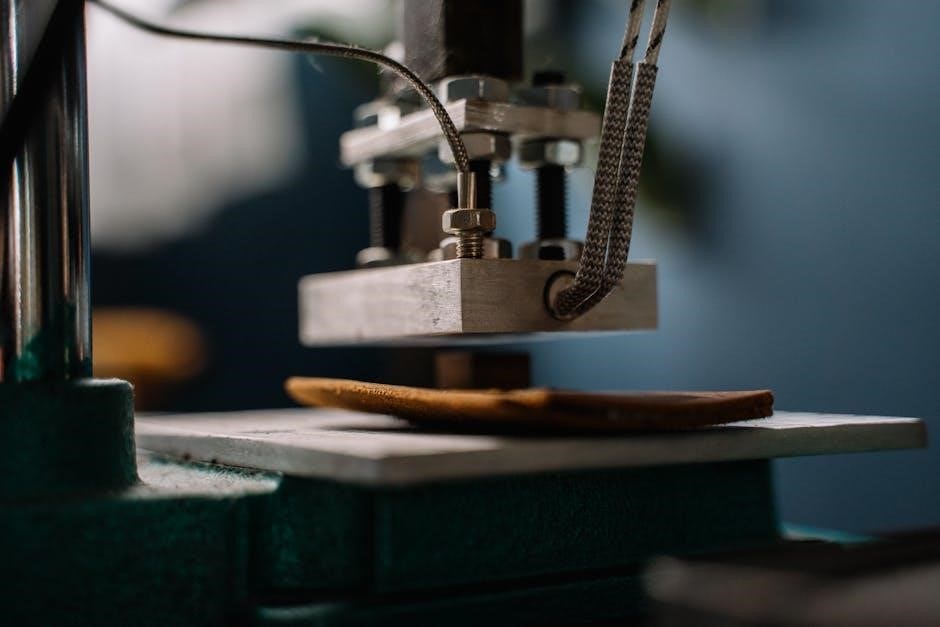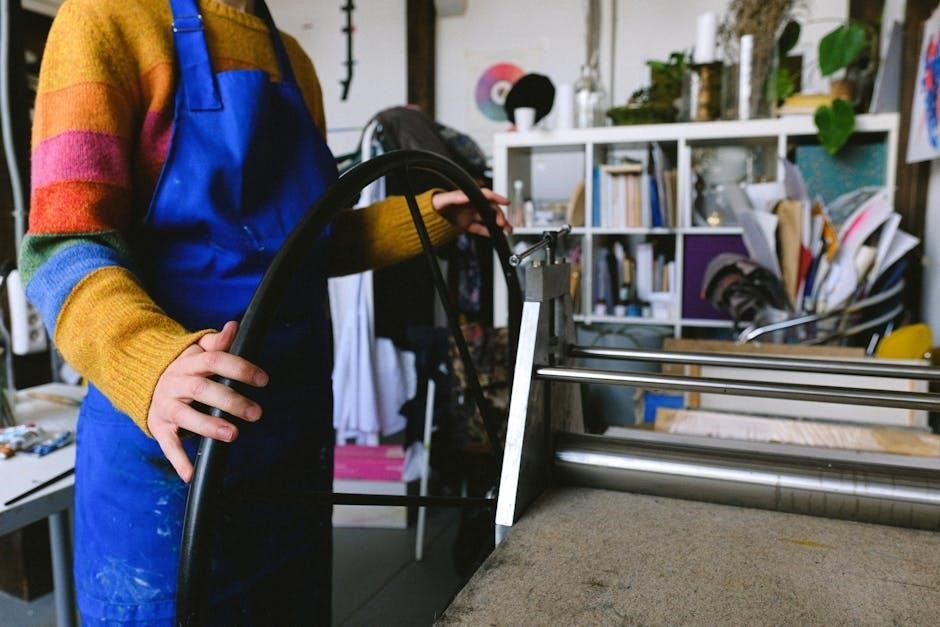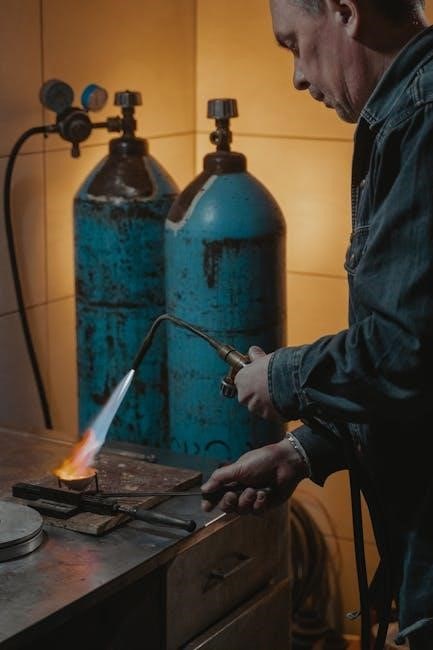Welcome to the Tusy Heat Press Manual, your comprehensive guide to mastering the machine’s features, operation, and maintenance. This manual ensures optimal performance and safety.
1.1 Overview of the Tusy Heat Press Machine

The Tusy Heat Press Machine is a versatile and advanced tool designed for heat transfer applications, including sublimation, plastisol, and heat-activated embroidery. It features automatic pressing, reducing manual effort and physical strain. With digital temperature control, users can precisely set and monitor heat settings, ensuring consistent results. The machine is suitable for various materials, making it ideal for both beginners and professionals. Its robust design and user-friendly interface allow for efficient operation, while safety features ensure a secure working environment. Whether for crafting, commercial projects, or DIY enthusiasts, the Tusy Heat Press delivers high-quality performance and durability, making it a reliable choice for heat transfer needs.
1.2 Importance of Reading the Manual
Reading the Tusy Heat Press Manual is essential for safe and effective operation. It provides critical information on setup, temperature control, and maintenance, ensuring optimal performance. The manual highlights safety precautions to prevent accidents and outlines troubleshooting steps for common issues. Understanding the machine’s features, such as digital temperature control and automatic pressure adjustment, is vital for achieving professional results. By following the manual, users can avoid damaging materials and extend the machine’s lifespan. Whether you’re a beginner or experienced, the manual serves as a comprehensive guide to mastering the Tusy Heat Press. Neglecting it may lead to improper usage, reducing efficiency and increasing risks. Always refer to the manual for best practices and to resolve any operational challenges.

Setting Up the Tusy Heat Press
Begin by unboxing and inventorying all components. Assemble the machine according to the manual’s instructions. Perform initial calibration and testing to ensure proper function and safety.
2.1 Unboxing and Inventory
When you receive your Tusy Heat Press, carefully unbox and inspect all components. Ensure the package includes the main machine, power cord, user manual, and any additional accessories. Check for any visible damage or missing items. Inventorying helps verify that everything is accounted for before assembly. This step is crucial to prevent issues during setup. Take note of each part’s purpose to avoid confusion later. If any items are damaged or missing, contact customer support immediately. Proper inventory ensures a smooth assembly process and readiness for initial calibration. A thorough check now saves time and frustration in the future.
2.2 Assembling the Machine
Begin by placing the Tusy Heat Press on a stable, flat surface. Connect the power cord to a nearby outlet and ensure the machine is positioned away from flammable materials. Attach the heat press plate securely to the machine base, following the alignment guides. Tighten all screws firmly to prevent any movement during operation. Next, adjust the pressure knob to achieve even pressure distribution. Double-check all connections to ensure they are secure. If unsure about any step, refer to the provided diagrams in the manual. Proper assembly is essential for safe and efficient operation. Once assembled, plug in the machine and proceed to the initial calibration step. Always follow safety guidelines to avoid accidents during setup. Ensure the machine is out of reach of children and pets during assembly. Proper ventilation is also recommended to prevent overheating risks.
2.3 Initial Calibration and Testing
Once assembled, plug in the Tusy Heat Press and turn it on. Set the desired temperature and time using the digital controls. Allow the machine to heat up until the indicator light confirms the set temperature is reached. Perform a test run without any materials to ensure proper function. If the display shows a temperature higher than actual, adjust the settings using the provided calibration instructions. Conduct a trial press with scrap fabric to verify even pressure and heat distribution. Calibration ensures accurate temperature and pressure control, which are critical for consistent results. Always follow the manual’s guidelines for testing to avoid damage and ensure safe operation. Proper calibration guarantees optimal performance and prevents potential issues during use. Regular testing helps maintain machine efficiency and longevity. Adjustments should be made carefully to avoid overheating or underheating. If unsure, refer to the troubleshooting section for solutions. Proper calibration is the foundation of successful heat pressing. Ensure all settings are accurate before proceeding to actual projects. This step ensures the machine operates within safe and effective parameters. Regular testing also helps identify any wear or tear early on, preventing major repairs. Always prioritize calibration for the best outcomes.

Operating the Tusy Heat Press
Open the press by lifting the handle, set the desired temperature and time, and wait for it to heat up. Start the timer and press. Always follow safety guidelines during operation.
3.1 Heating Up the Machine
To begin, lift the handle to open the heat press. Plug in the machine and switch it on. Use the control panel to set your desired temperature and time. The machine will start heating up automatically. Ensure the heating plate is closed during this process. You will know the machine is ready when it reaches the set temperature and emits a beep or light indication. Always preheat the press before starting your project for even heat distribution. Never leave the machine unattended while it is heating up. Proper heating is crucial for achieving the best results in your projects. Follow the manufacturer’s guidelines for optimal performance and safety.
3.2 Adjusting Temperature and Time
Adjusting the temperature and time on the Tusy Heat Press is straightforward. Use the control panel to set your desired temperature, ensuring it matches the material you are working with. The temperature range is typically between 200°F to 400°F. Once set, the machine will display the target temperature and begin heating. For time settings, use the digital controls to input the recommended duration for your project. Always refer to the material’s instructions for precise settings. Fine-tune the temperature and time as needed during the pressing process. Proper calibration ensures consistent results. After setting, allow the machine to reach the desired temperature before starting your project. This step is crucial for achieving professional-quality outcomes. Always test settings on a small sample before working on your final piece.
3.3 Pressing Process
Once the machine is preheated, lift the handle to open the heat press. Place your material, such as fabric or vinyl, on the lower platen, ensuring it is centered and evenly spread. Close the press firmly, adjusting the pressure knob to secure it tightly. Press the start button to begin the countdown timer. The machine will apply consistent heat and pressure. When the timer beeps, carefully open the press by lifting the handle. Allow the material to cool slightly before handling. Always ensure the pressing area is clear of debris and the material is properly aligned. Follow these steps to achieve professional-quality results with your Tusy Heat Press.
3.4 Cooling Down
After completing the pressing process, allow the machine to cool down properly to ensure longevity and safety. Turn off the power switch and unplug the machine to prevent residual heat. Let the heating plate and press surfaces cool naturally; never use water or wet cloths to speed up the process, as this can damage the machine. Use heat-resistant gloves if handling the press during cooldown. Clean any residue from the platens while they are still warm but not hot. Regular cooling ensures optimal performance and prevents overheating issues. Always refer to the manual for specific cooldown procedures tailored to your Tusy Heat Press model.

Maintenance and Care
Regular maintenance is crucial for extending the lifespan of your Tusy Heat Press. Clean the machine, lubricate moving parts, and replace worn components to ensure optimal performance.
4.1 Cleaning the Heat Press
Regular cleaning is essential for maintaining the performance of your Tusy Heat Press. Turn off and unplug the machine, allowing it to cool completely before cleaning. Use a soft, dry cloth to wipe down the heat press plate and surrounding areas. Avoid using harsh chemicals or abrasive materials, as they may damage the surface. For stubborn residue, a slightly damp cloth can be used, but ensure the machine is dry before reuse. Clean the silicone pad gently to prevent tearing. Check for dust or debris in moving parts and remove them with compressed air. Regular cleaning prevents the buildup of residue and ensures consistent heat distribution. Clean the press after each use for optimal results. This practice prolongs the machine’s lifespan and maintains its efficiency. Always follow these steps to keep your Tusy Heat Press in excellent condition.
4.2 Lubricating Moving Parts
Regular lubrication of the Tusy Heat Press’s moving parts is crucial for smooth operation and longevity. Use a high-quality silicone-based spray or grease to lubricate the hinge and pressure adjustment mechanisms. Ensure the machine is cool and unplugged before applying lubricant. Spray or apply a small amount to the moving joints, then wipe off any excess with a clean cloth. Avoid lubricating the heat press plate or nearby electrical components. Proper lubrication reduces friction and prevents wear on critical parts. Repeat this process every 2-3 months or when you notice stiff movement. This maintenance step ensures the machine operates efficiently and maintains consistent pressure during use. Regular lubrication is key to extending the lifespan of your Tusy Heat Press. Always follow safety precautions when performing this task.
4.3 Replacing Wearable Parts
Regular inspection and replacement of wearable parts ensure the Tusy Heat Press operates efficiently. Check components like the heating plate, pressure knob, and silicone pad for signs of wear or damage. Replace the heating plate if it shows discoloration or uneven heat distribution. The silicone pad should be replaced if it loses its shape or becomes worn. To replace parts, turn off and unplug the machine, allowing it to cool completely. Remove the old part and install the new one according to the manufacturer’s instructions. Always use genuine Tusy replacement parts to maintain performance and safety. Proper replacement prevents damage to the machine and ensures consistent results. Regular maintenance extends the lifespan of your heat press and guarantees optimal performance. Replace parts promptly to avoid operational issues.

Troubleshooting Common Issues
Identify and resolve common issues like uneven pressure, temperature discrepancies, or timer malfunctions. Adjust settings, clean, or replace parts as needed to ensure smooth operation.
5.1 Pressure Issues
Pressure issues can affect the quality of your heat press results. If the press feels too loose or too tight, adjust the pressure adjustment knob to achieve even distribution. Ensure the heat press plate is aligned properly with the base. If uneven pressure persists, check for worn-out silicone pads or springs and replace them as needed. Clean the press plate regularly to prevent residue buildup, which can interfere with pressure application. For severe issues, refer to the manual for recalibration instructions or contact customer support. Always ensure the machine is on a stable, flat surface to maintain consistent pressure during operation.

5.2 Temperature Discrepancies
Temperature discrepancies can lead to inconsistent heating, affecting the quality of your projects. If the displayed temperature differs from the actual heat press temperature, calibrate the machine. Press the adjustment button to increase or decrease the temperature as needed. Ensure the thermistor is clean and securely connected. If issues persist, refer to the manual for advanced calibration steps. Avoid touching the heating plate during operation, as it can cause burns. Always allow the machine to cool down before performing any adjustments. Regular maintenance, such as cleaning and checking connections, helps prevent temperature inaccuracies. Consult the troubleshooting section for further guidance if the problem persists.
5.3 Timer Malfunction
If the timer on your Tusy Heat Press malfunctions, it may not start or stop correctly, affecting your pressing process. First, ensure the machine is properly plugged in and powered on. Check if the start/stop button is functioning correctly. If the timer counts down too quickly or slowly, recalibrate it by adjusting the parameter settings in the control panel. Refer to the manual for specific calibration instructions. If the issue persists, inspect for loose connections or a faulty timer module. Always unplug the machine before performing internal inspections. Contact customer support if the problem cannot be resolved through basic troubleshooting. Proper timer function is essential for achieving consistent results in your heat pressing projects.

Safety Precautions
Always prioritize safety when using the Tusy Heat Press. Avoid touching hot surfaces, keep the area well-ventilated, and ensure supervision while operating. Follow all guidelines to prevent accidents.
6.1 General Safety Guidelines
Ensure a safe working environment when using the Tusy Heat Press. Always keep children and pets away from the machine. Never touch the heating plate or press plate during operation, as they become extremely hot. Use heat-resistant gloves if necessary. Maintain proper ventilation in the workspace to avoid inhaling fumes from materials. Avoid overloading the machine, and ensure it is placed on a stable, heat-resistant surface. Keep the power cord away from water and heat sources. Regularly inspect the machine for damage or wear. Follow all safety instructions provided in the manual to prevent accidents and ensure optimal performance. Supervision is recommended when the machine is in use.
6.2 Emergency Procedures
In case of an emergency, immediately turn off the machine and unplug it from the power source. Do not attempt to operate the heat press until it has cooled down completely. If a burn occurs, run cool tap water over the affected area for 10-15 minutes and seek medical attention if necessary. For any malfunction, such as unexpected noises or smoke, disconnect the power and contact a professional. Never use water to extinguish electrical fires; instead, use a fire extinguisher rated for electrical fires. Keep a fire extinguisher nearby and ensure all users are aware of its location. After resolving the issue, perform a thorough inspection before resuming use. Always prioritize safety to prevent accidents and ensure the machine operates effectively.

Advanced Techniques
Explore advanced methods like heat transfer vinyl application and sublimation printing. Discover how to handle intricate designs and multiple material types efficiently with the Tusy Heat Press.
7.1 Heat Transfer Vinyl Application
Heat Transfer Vinyl (HTV) application is a popular method for creating custom designs on fabrics. It involves cutting vinyl sheets into desired shapes and transferring them using heat and pressure. For best results, preheat the Tusy Heat Press to the recommended temperature, typically between 270°F and 300°F, depending on the vinyl type. Place the vinyl on the garment, ensuring it is centered and smooth. Use the press’s digital controls to set the appropriate time, usually 10-15 seconds for most HTV. Apply firm, even pressure to ensure a strong bond. Allow the garment to cool before handling to prevent stretching or peeling. This method is ideal for intricate designs and durable finishes, making it a favorite for crafters and professionals alike.
7.2 Sublimation Printing
Sublimation printing is a versatile technique that uses heat to transfer vibrant, full-color designs onto various materials. The Tusy Heat Press excels in this process, ensuring crisp and durable results. Preheat the press to 380°F, ideal for sublimation. Place the sublimation paper on the target material, such as polyester fabric, ceramics, or glass. Set the timer for 3-4 minutes, depending on the material thickness. Apply even pressure to ensure proper ink transfer. After pressing, allow the material to cool before handling. This method is perfect for creating vibrant, long-lasting designs on a wide range of surfaces. Always use sublimation-specific ink and paper for optimal results. Proper temperature and pressure settings are key to achieving professional-quality finishes with the Tusy Heat Press.

Key Features of the Tusy Heat Press
The Tusy Heat Press boasts digital temperature control, automatic pressure adjustment, and a large pressing surface for versatile and precise heat transfer applications, ensuring professional-grade results effortlessly.
8.1 Digital Temperature Control
The Tusy Heat Press features an advanced digital temperature control system, allowing precise adjustments between 0°F to 400°F. This ensures accurate heat settings for various materials like vinyl, sublimation, and more. The LED display provides clear temperature readings, enabling users to monitor and maintain optimal conditions effortlessly. This feature is crucial for achieving consistent results in heat transfer processes. With digital control, users can avoid overheating, which might damage materials or cause unwanted effects. The system also allows for quick temperature changes, enhancing efficiency during multiple projects. This level of control makes the Tusy Heat Press suitable for both beginners and experienced crafters seeking professional-quality outcomes.
8.2 Automatic Pressure Adjustment
The Tusy Heat Press is equipped with an automatic pressure adjustment feature, designed to eliminate manual effort and ensure even pressure distribution. This mechanism guarantees consistent results across various materials, from delicate fabrics to thick substrates. The system automatically adjusts to the thickness of the material being pressed, preventing over- or under-pressure issues. This feature enhances safety by reducing the risk of damage to the machine or the substrate. It also streamlines the pressing process, making it more efficient and user-friendly. Whether you’re working with heat transfer vinyl, sublimation, or other materials, the automatic pressure adjustment ensures professional-quality outcomes with minimal effort. This innovation makes the Tusy Heat Press a versatile tool for crafters and professionals alike.
Best Practices for Optimal Results
- Always pre-test materials to ensure compatibility with heat and pressure.
- Use recommended temperature and time settings for specific materials.
- Ensure proper alignment of designs before pressing.
- Avoid overheating to prevent damage to substrates or transfers.
9.1 Choosing the Right Materials
Selecting the appropriate materials is crucial for achieving professional results with the Tusy Heat Press. Ensure your substrate, such as fabric or ceramic, is compatible with heat transfer processes. Heat transfer vinyl (HTV) is ideal for fabrics, while sublimation paper works best for ceramics and glass. Always verify the material’s temperature and time requirements to avoid damage. For HTV, use a soft, even surface to ensure proper adhesion. Opt for high-quality transfers to prevent peeling or fading. Proper material selection ensures vibrant, long-lasting designs. Refer to the manual for specific guidelines on compatible materials and settings to maximize your results with the Tusy Heat Press.
9.2 Optimizing Pressing Time and Temperature
Optimizing pressing time and temperature is essential for achieving professional-quality results with your Tusy Heat Press. Different materials require specific settings to ensure proper adhesion and durability. For heat transfer vinyl (HTV), typical settings range between 300°F to 350°F for 10 to 20 seconds. Sublimation printing may require higher temperatures, around 400°F for 30 to 60 seconds. Always reference the material manufacturer’s guidelines for precise settings. Incorrect temperature or time can lead to peeling, discoloration, or damage to the substrate. Adjustments may be needed based on the thickness or type of material. Testing with scrap material is recommended to ensure optimal results. Proper calibration ensures consistent and professional outcomes with the Tusy Heat Press.
The Tusy Heat Press Manual has provided a comprehensive guide to understanding and utilizing your machine effectively. From initial setup to advanced techniques, this manual ensures you achieve professional-quality results. By following the safety precautions, maintenance tips, and best practices outlined, you can extend the life of your machine and consistently produce exceptional work. Whether you’re working with heat transfer vinyl, sublimation, or other materials, the Tusy Heat Press is a reliable tool for your creative projects. Refer to this manual regularly to refresh your knowledge and troubleshoot any issues. With proper care and operation, your Tusy Heat Press will remain a vital asset for years to come.